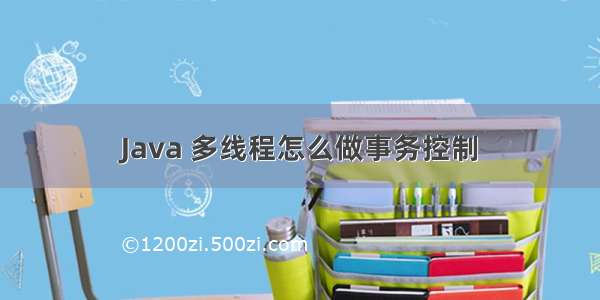
前言
公司业务中遇到一个需求,需要同时修改最多约5万条数据,而且还不支持批量或异步修改操作。于是只能写个for循环操作,但操作耗时太长,只能一步一步寻找其他解决方案。
具体操作如下:
一、循环操作的代码
先写一个最简单的for循环代码,看看耗时情况怎么样。
/***
一条一条依次对50000条数据进行更新操作耗时:2m27s,1m54s
*/
@Test
void updateStudent() {
List allStudents = studentMapper.getAll();
allStudents.forEach(s -> {
//更新教师信息
String teacher = s.getTeacher();
String newTeacher = “TNO_” + new Random().nextInt(100);
s.setTeacher(newTeacher);
studentMapper.update(s);
});
}
循环修改整体耗时约 1分54秒,且代码中没有手动事务控制应该是自动事务提交,所以每次操作事务都会提交所以操作比较慢,我们先对代码中添加手动事务控制,看查询效率怎样。
最新面试题整理:/mst/
二、使用手动事务的操作代码
修改后的代码如下:
@Autowired
private DataSourceTransactionManager dataSourceTransactionManager;
@Autowired
private TransactionDefinition transactionDefinition;
/**
由于希望更新操作 一次性完成,需要手动控制添加事务耗时:24s从测试结果可以看出,添加事务后插入数据的效率有明显的提升
*/
@Test
void updateStudentWithTrans() {
List allStudents = studentMapper.getAll();
TransactionStatus transactionStatus = dataSourceTransactionManager.getTransaction(transactionDefinition);
try {
allStudents.forEach(s -> {
//更新教师信息
String teacher = s.getTeacher();
String newTeacher = “TNO_” + new Random().nextInt(100);
s.setTeacher(newTeacher);
studentMapper.update(s);
});
mit(transactionStatus);
} catch (Throwable e) {
dataSourceTransactionManager.rollback(transactionStatus);
throw e;
}
}
添加手动事务操控制后,整体耗时约 24秒,这相对于自动事务提交的代码,快了约5倍,对于大量循环数据库提交操作,添加手动事务可以有效提高操作效率。最新面试题整理好了,大家可以在Java面试库小程序在线刷题。
三、尝试多线程进行数据修改
添加数据库手动事务后操作效率有明细提高,但还是比较长,接下来尝试多线程提交看是不是能够再快一些。
先添加一个Service将批量修改操作整合一下,具体代码如下:
StudentServiceImpl.java
@Service
public class StudentServiceImpl implements StudentService {
@Autowired
private StudentMapper studentMapper;
@Autowiredprivate DataSourceTransactionManager dataSourceTransactionManager;@Autowiredprivate TransactionDefinition transactionDefinition;@Overridepublic void updateStudents(List<Student> students, CountDownLatch threadLatch) {TransactionStatus transactionStatus = dataSourceTransactionManager.getTransaction(transactionDefinition);System.out.println("子线程:" + Thread.currentThread().getName());try {students.forEach(s -> {// 更新教师信息// String teacher = s.getTeacher();String newTeacher = "TNO_" + new Random().nextInt(100);s.setTeacher(newTeacher);studentMapper.update(s);});mit(transactionStatus);threadLatch.countDown();} catch (Throwable e) {e.printStackTrace();dataSourceTransactionManager.rollback(transactionStatus);}}
}
批量测试代码,我们采用了多线程进行提交,修改后测试代码如下:
@Autowired
private DataSourceTransactionManager dataSourceTransactionManager;
@Autowired
private TransactionDefinition transactionDefinition;
@Autowired
private StudentService studentService;
/**
对用户而言,27s 任是一个较长的时间,我们尝试用多线程的方式来经行修改操作看能否加快处理速度
预计创建10个线程,每个线程进行5000条数据修改操作
耗时统计
1 线程数:1 耗时:25s
2 线程数:2 耗时:14s
3 线程数:5 耗时:15s
4 线程数:10 耗时:15s
5 线程数:100 耗时:15s
6 线程数:200 耗时:15s
7 线程数:500 耗时:17s
8 线程数:1000 耗时:19s
8 线程数:2000 耗时:23s
8 线程数:5000 耗时:29s
*/
@Test
void updateStudentWithThreads() {
//查询总数据
List allStudents = studentMapper.getAll();
// 线程数量
final Integer threadCount = 100;
//每个线程处理的数据量
final Integer dataPartionLength = (allStudents.size() + threadCount - 1) / threadCount;
// 创建多线程处理任务
ExecutorService studentThreadPool = Executors.newFixedThreadPool(threadCount);
CountDownLatch threadLatchs = new CountDownLatch(threadCount);
for (int i = 0; i < threadCount; i++) {
// 每个线程处理的数据
List threadDatas = allStudents.stream()
.skip(i * dataPartionLength).limit(dataPartionLength).collect(Collectors.toList());
studentThreadPool.execute(() -> {
studentService.updateStudents(threadDatas, threadLatchs);
});
}
try {
// 倒计时锁设置超时时间 30s
threadLatchs.await(30, TimeUnit.SECONDS);
} catch (Throwable e) {
e.printStackTrace();
}
System.out.println(“主线程完成”);
}
Spring Boot 基础就不介绍了,推荐下这个实战教程:/javastacks/spring-boot-best-practice
多线程提交修改时,我们尝试了不同线程数对提交速度的影响,具体可以看下面表格,
图片多线程修改50000条数据时 不同线程数耗时对比(秒)
根据表格,我们线程数增大提交速度并非一直增大,在当前情况下约在2-5个线程数时,提交速度最快(实际线程数还是需要根据服务器配置实际测试)。
另外,MySQL 系列面试题和答案全部整理好了,微信搜索Java技术栈,在后台发送:面试,可以在线阅读。
四、基于两个CountDownLatch控制多线程事务提交
由于多线程提交时,每个线程事务时单独的,无法保证一致性,我们尝试给多线程添加事务控制,来保证每个线程都是在插入数据完成后在提交事务,
这里我们使用两个 CountDownLatch 来控制主线程与子线程事务提交,并设置了超时时间为 30 秒。我们对代码进行了一点修改:
@Override
public void updateStudentsThread(List students, CountDownLatch threadLatch, CountDownLatch mainLatch, StudentTaskError taskStatus) {
TransactionStatus transactionStatus = dataSourceTransactionManager.getTransaction(transactionDefinition);
System.out.println(“子线程:” + Thread.currentThread().getName());
try {
students.forEach(s -> {
// 更新教师信息
// String teacher = s.getTeacher();
String newTeacher = “TNO_” + new Random().nextInt(100);
s.setTeacher(newTeacher);
studentMapper.update(s);
});
} catch (Throwable e) {
taskStatus.setIsError();
} finally {
threadLatch.countDown(); // 切换到主线程执行
}
try {
mainLatch.await(); //等待主线程执行
} catch (Throwable e) {
taskStatus.setIsError();
}
// 判断是否有错误,如有错误 就回滚事务
if (taskStatus.getIsError()) {
dataSourceTransactionManager.rollback(transactionStatus);
} else {
mit(transactionStatus);
}
}
/**
由于每个线程都是单独的事务,需要添加对线程事务的统一控制
我们这边使用两个 CountDownLatch 对子线程的事务进行控制
*/
@Test
void updateStudentWithThreadsAndTrans() {
//查询总数据
List allStudents = studentMapper.getAll();
// 线程数量
final Integer threadCount = 4;
//每个线程处理的数据量
final Integer dataPartionLength = (allStudents.size() + threadCount - 1) / threadCount;
// 创建多线程处理任务
ExecutorService studentThreadPool = Executors.newFixedThreadPool(threadCount);
CountDownLatch threadLatchs = new CountDownLatch(threadCount); // 用于计算子线程提交数量
CountDownLatch mainLatch = new CountDownLatch(1); // 用于判断主线程是否提交
StudentTaskError taskStatus = new StudentTaskError(); // 用于判断子线程任务是否有错误
for (int i = 0; i < threadCount; i++) {
// 每个线程处理的数据
List threadDatas = allStudents.stream()
.skip(i * dataPartionLength).limit(dataPartionLength)
.collect(Collectors.toList());
studentThreadPool.execute(() -> {
studentService.updateStudentsThread(threadDatas, threadLatchs, mainLatch, taskStatus);
});
}
try {
// 倒计时锁设置超时时间 30s
boolean await = threadLatchs.await(30, TimeUnit.SECONDS);
if (!await) { // 等待超时,事务回滚
taskStatus.setIsError();
}
} catch (Throwable e) {
e.printStackTrace();
taskStatus.setIsError();
}
mainLatch.countDown(); // 切换到子线程执行
studentThreadPool.shutdown(); //关闭线程池
System.out.println(“主线程完成”);
}
本想再次测试一下不同线程数对执行效率的影响时,发现当线程数超过10个时,执行时就报错。具体错误内容如下:
Exception in thread “pool-1-thread-2” org.springframework.transaction.CannotCreateTransactionException: Could not open JDBC Connection for transaction; nested exception is java.sql.SQLTransientConnectionException: HikariPool-1 - Connection is not available, request timed out after 30055ms.
at org.springframework.jdbc.datasource.DataSourceTransactionManager.doBegin(DataSourceTransactionManager.java:309)
at org.springframework.transaction.support.AbstractPlatformTransactionManager.startTransaction(AbstractPlatformTransactionManager.java:400)
at org.springframework.transaction.support.AbstractPlatformTransactionManager.getTransaction(AbstractPlatformTransactionManager.java:373)
at com.example.springbootmybatis.service.Impl.StudentServiceImpl.updateStudentsThread(StudentServiceImpl.java:58)
at com.example.springbootmybatis.StudentTest.lambda$updateStudentWithThreadsAndTrans 3 ( S t u d e n t T e s t . j a v a : 164 ) a t j a v a . u t i l . c o n c u r r e n t . T h r e a d P o o l E x e c u t o r . r u n W o r k e r ( T h r e a d P o o l E x e c u t o r . j a v a : 1149 ) a t j a v a . u t i l . c o n c u r r e n t . T h r e a d P o o l E x e c u t o r 3(StudentTest.java:164) at java.util.concurrent.ThreadPoolExecutor.runWorker(ThreadPoolExecutor.java:1149) at java.util.concurrent.ThreadPoolExecutor 3(StudentTest.java:164)atjava.util.concurrent.ThreadPoolExecutor.runWorker(ThreadPoolExecutor.java:1149)atjava.util.concurrent.ThreadPoolExecutorWorker.run(ThreadPoolExecutor.java:624)
at java.lang.Thread.run(Thread.java:748)
Caused by: java.sql.SQLTransientConnectionException: HikariPool-1 - Connection is not available, request timed out after 30055ms.
at com.zaxxer.hikari.pool.HikariPool.createTimeoutException(HikariPool.java:696)
at com.zaxxer.hikari.pool.HikariPool.getConnection(HikariPool.java:197)
at com.zaxxer.hikari.pool.HikariPool.getConnection(HikariPool.java:162)
at com.zaxxer.hikari.HikariDataSource.getConnection(HikariDataSource.java:128)
at org.springframework.jdbc.datasource.DataSourceTransactionManager.doBegin(DataSourceTransactionManager.java:265)
… 7 more
错误的大致意思时,不能为数据库事务打开 jdbc Connection,连接在30s的时候超时了。由于前面启动的十个线程需要等待主线程完成后才能提交,所以一直占用连接未释放,造成后面的进程创建连接超时。
看错误日志中错误的来源是 HikariPool ,我们来重新配置一下这个连接池的参数,将最大连接数修改为100,具体配置如下:
连接池中允许的最小连接数。缺省值:10
spring.datasource.hikari.minimum-idle=10
连接池中允许的最大连接数。缺省值:10
spring.datasource.hikari.maximum-pool-size=100
自动提交
spring.datasource.hikari.auto-commit=true
一个连接idle状态的最大时长(毫秒),超时则被释放(retired),缺省:10分钟
spring.datasource.hikari.idle-timeout=30000
一个连接的生命时长(毫秒),超时而且没被使用则被释放(retired),缺省:30分钟,建议设置比数据库超时时长少30秒
spring.datasource.hikari.max-lifetime=1800000
等待连接池分配连接的最大时长(毫秒),超过这个时长还没可用的连接则发生SQLException, 缺省:30秒
再次执行测试发现没有报错,修改线程数为20又执行了一下,同样执行成功了。最新 MySQL 面试题整理好了,大家可以在Java面试库小程序在线刷题。
五、基于TransactionStatus集合来控制多线程事务提交
在同事推荐下我们使用事务集合来进行多线程事务控制,主要代码如下
@Service
public class StudentsTransactionThread {
@Autowiredprivate StudentMapper studentMapper;@Autowiredprivate StudentService studentService;@Autowiredprivate PlatformTransactionManager transactionManager;List<TransactionStatus> transactionStatuses = Collections.synchronizedList(new ArrayList<TransactionStatus>());@Transactional(propagation = Propagation.REQUIRED, rollbackFor = {Exception.class})public void updateStudentWithThreadsAndTrans() throws InterruptedException {//查询总数据List<Student> allStudents = studentMapper.getAll();// 线程数量final Integer threadCount = 2;//每个线程处理的数据量final Integer dataPartionLength = (allStudents.size() + threadCount - 1) / threadCount;// 创建多线程处理任务ExecutorService studentThreadPool = Executors.newFixedThreadPool(threadCount);CountDownLatch threadLatchs = new CountDownLatch(threadCount);AtomicBoolean isError = new AtomicBoolean(false);try {for (int i = 0; i < threadCount; i++) {// 每个线程处理的数据List<Student> threadDatas = allStudents.stream().skip(i * dataPartionLength).limit(dataPartionLength).collect(Collectors.toList());studentThreadPool.execute(() -> {try {try {studentService.updateStudentsTransaction(transactionManager, transactionStatuses, threadDatas);} catch (Throwable e) {e.printStackTrace();isError.set(true);}finally {threadLatchs.countDown();}} catch (Exception e) {e.printStackTrace();isError.set(true);}});}// 倒计时锁设置超时时间 30sboolean await = threadLatchs.await(30, TimeUnit.SECONDS);// 判断是否超时if (!await) {isError.set(true);}} catch (Throwable e) {e.printStackTrace();isError.set(true);}if (!transactionStatuses.isEmpty()) {if (isError.get()) {transactionStatuses.forEach(s -> transactionManager.rollback(s));} else {transactionStatuses.forEach(s -> mit(s));}}System.out.println("主线程完成");}
}
@Override
@Transactional(propagation = Propagation.REQUIRED, rollbackFor = {Exception.class})
public void updateStudentsTransaction(PlatformTransactionManager transactionManager, List transactionStatuses, List students) {
// 使用这种方式将事务状态都放在同一个事务里面
DefaultTransactionDefinition def = new DefaultTransactionDefinition();
def.setPropagationBehavior(TransactionDefinition.PROPAGATION_REQUIRES_NEW); // 事物隔离级别,开启新事务,这样会比较安全些。
TransactionStatus status = transactionManager.getTransaction(def); // 获得事务状态
transactionStatuses.add(status);
students.forEach(s -> {// 更新教师信息// String teacher = s.getTeacher();String newTeacher = "TNO_" + new Random().nextInt(100);s.setTeacher(newTeacher);studentMapper.update(s);});System.out.println("子线程:" + Thread.currentThread().getName());
}
由于这个中方式去前面方式相同,需要等待线程执行完成后才会提交事务,所有任会占用Jdbc连接池,如果线程数量超过连接池最大数量会产生连接超时。所以在使用过程中任要控制线程数量,
六、使用union连接多个select实现批量update
有些情况写不支持,批量update,但支持insert 多条数据,这个时候可尝试将需要更新的数据拼接成多条select 语句,然后使用union 连接起来,再使用update 关联这个数据进行update,具体代码演示如下:
update student,(
(select 1 as id,‘teacher_A’ as teacher) union
(select 2 as id,‘teacher_A’ as teacher) union
(select 3 as id,‘teacher_A’ as teacher) union
(select 4 as id,‘teacher_A’ as teacher)
/* …more data … */
) as new_teacher
set
student.teacher=new_teacher.teacher
where
student.id=new_teacher.id
这种方式在Mysql 数据库没有配置 allowMultiQueries=true 也可以实现批量更新。
总结
对于大批量数据库操作,使用手动事务提交可以很多程度上提高操作效率
多线程对数据库进行操作时,并非线程数越多操作时间越快,按上述示例大约在2-5个线程时操作时间最快。
对于多线程阻塞事务提交时,线程数量不能过多。
如果能有办法实现批量更新那是最好














